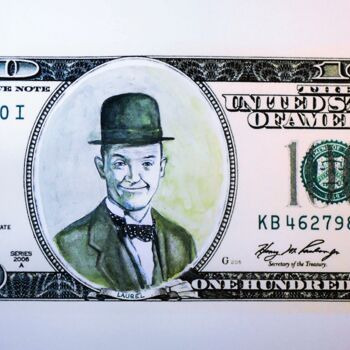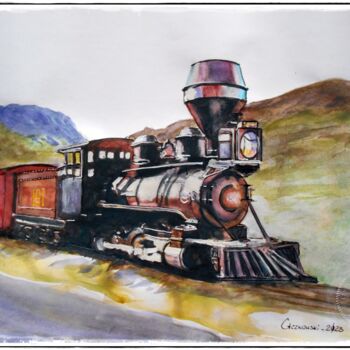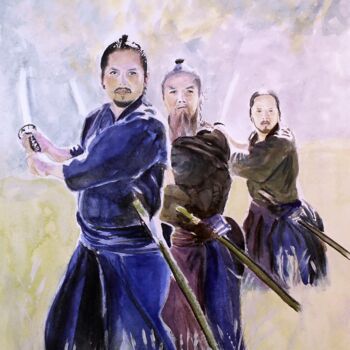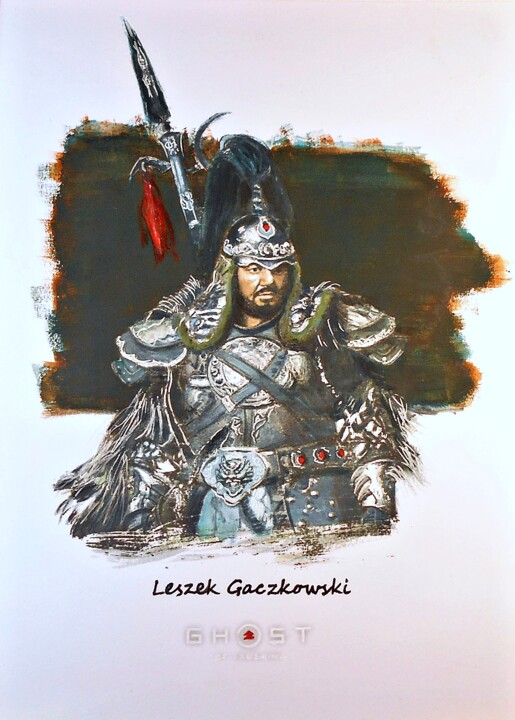
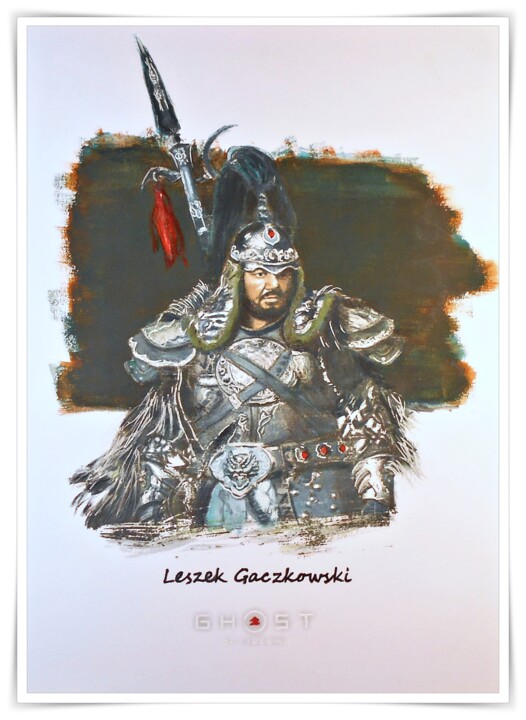
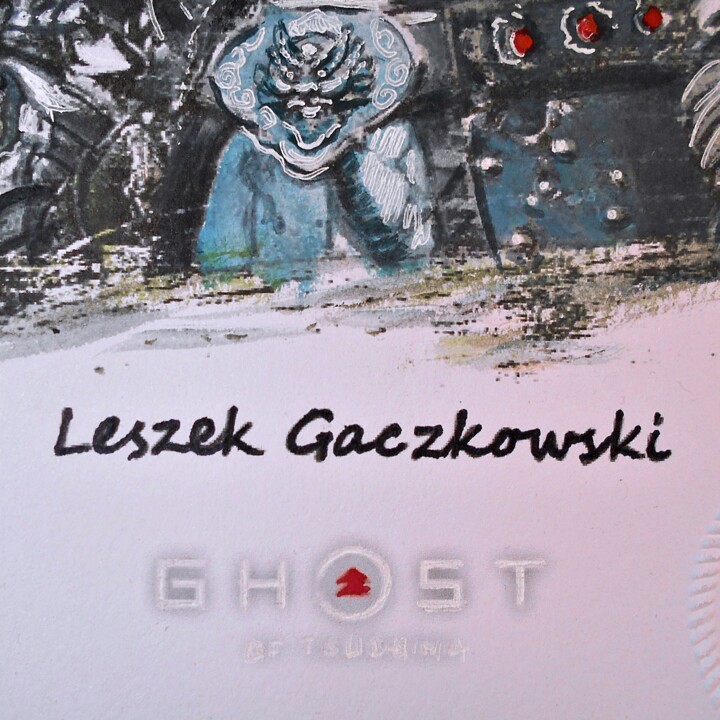
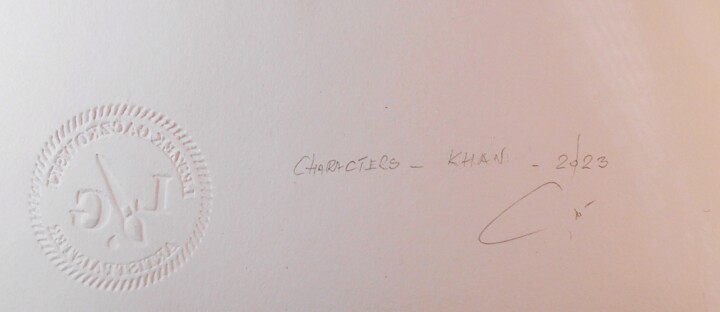


Faites-nous savoir si vous souhaitez voir plus de photos de cette œuvre !
- Arrière de l'oeuvre / Côté de l'oeuvre
- Détails / Signature / Surface ou texture de l'œuvre
- Oeuvre en situation, Autre...
GHOST OF TSUSHIMA 002 / 23 - CHARACTERS - Khan - (2023) (2023) Peinture par Leszek Gaczkowski
Plus d'info
- Emballage (Boîte ou emballage en carton) Toutes les œuvres sont expédiées soigneusement protégées et assurées, avec un transporteur premium.
- Suivi Suivi de commande jusqu'à la livraison à l'acheteur. Un numéro de suivi vous sera fourni afin que vous puissiez suivre le colis en temps réel.
- Délais La plupart des colis sont livrés dans le monde entier sous 1 à 3 semaines (Estimation)
- Douanes non incluses Le prix ne comprend pas les frais de douane. La plupart des pays n'ont pas de taxe à l'importation pour les œuvres d'art originales, mais vous devrez peut-être payer la TVA réduite. Les frais de douane (le cas échéant) sont à calculer à l'arrivée par le bureau de douane et seront facturés séparément par le transporteur.
Plus d'info
- Certificat d'authenticité en ligne traçable Les certificats d'authenticité peuvent être vérifiés en ligne à tout moment en scannant le code de l'oeuvre.
- Certification de la cote artiste Les experts étudient l'œuvre et la carrière d'un artiste puis établissent une cotation moyenne indépendante et fiable. La cotation moyenne permet de situer l'artiste sur une gamme de prix pour une période donnée. Les experts peuvent également être sollicités pour établir une estimation plus précise pour une œuvre en particulier.
Plus d'info
Paiement 100% sécurisé avec un certificat SSL + 3D Secure.
Plus d'info
Cette impression est disponible en plusieurs tailles.
Vendu par Leszek Gaczkowski
Cette image est disponible pour téléchargement avec une licence
Vendu par Leszek Gaczkowski
-
Œuvre d'art originale (One Of A Kind)
Peinture,
Gouache
sur Papier
- Dimensions Hauteur 11,7in, Largeur 8,3in
- État de l'œuvre L'oeuvre est en parfait état
- Encadrement Cette oeuvre n'est pas encadrée
- Catégories Peintures à moins de 500 $US Art conceptuel Jeu vidéo
Khotun Khan is a cousin of Kublai Khan and grandson of Genghis Khan. He grew up to be a very successful and well-known General in the Mongol Empire. But he originally grew up in China. Shortly before the Goryeo campaign, he released his favorite golden eagle, nicknamed Little Brother. Following the conquest of Goryeo, Khotun was engaged in a conquest of Japan. The Khan was eagerly ambitious, and if he was successful, he would not only spread his name but would be able to vie for the title of Great Khan himself. Before leading the invasion, Khotun learned the Japanese language and used spies and informants to learn about Japan's history, politics, and culture.
Khotun began his conquest of Japan by invading the island of Tsushima. Khotun set out for Tsushima with a large invasion force consisting of thousands of Mongols, including of one his best generals, Temuge, aboard a massive Mongol fleet that he intends to use to blockade the island.
The Khan and the Mongols made landfall at Komoda Beach, where they became involved in a standoff with the island's samurais, led by Shimura. and his nephew Sakai, Harunobu Adachi attempts to challenge the Khan to single combat, and he replies by lighting the Samurai on fire and beheading him, an act that knowingly insults the samurai code of bushido. This enraged Shimura into ordering a frontal charge, resulting in the decimation of the Samurai. Knowing that the jito is more valuable alive, Khotun captures him alive and reveals his identity to him, explaining how he had prepared for this invasion. The Khan knocks Shimura out when he silently refuses to surrender and takes him to Castle Kaneda. The castle is soon attacked by Lord Shimura's nephew Jin Sakai, who fights his way through the Mongols to rescue his uncle and confronts the Khan on the Castle's bridge. Jin challenges the Khan to single combat but is swiftly defeated. Khotun asks Jin to surrender, but when his face is cut by Jin, the Khan throws Jin from the bridge to the waters below.
Meanwhile, the Khan's forces advance across the isle, pillaging and destroying many settlements, temples, and garrisons and setting up camps and strongholds along the way. During this time, Khotun engages in frequent conversations with a local monk, Daizo, who seeks to document his words and deeds in order to foster mutual understanding and prevent more bloodshed, partially out of eagerness to learn more about Japanese culture and history. Khotun confides in the monk that he plans to convince Shimura to join the Mongol cause, and offer to make him Shogun and let him rule Japan as Khotun's right-hand man, as well as aiding Khotun in overthrowing Kublai.
Khotun makes several attempts to convince Shimura to join his cause, counting on Shimura's over-reliance on the traditions of the samurai. Shimura is unwilling to speak to the Khan until he learns that Jin survived the earlier confrontation with Khotun. Noting the love that Shimura has for his nephew, Khotun asks the jito if he will abandon his children to their savage demises at the hands of the Mongols, noting that surrendering could ensure their safety. Shimura responds that he and Lord Sakai will fight until their last breath. The next time Khotun visits the imprisoned Jito, he gives him an update on Jin's activities: his men have found their brothers stabbed in the back, a direct violation of the Samurai honor code, which Shimura had used to enforce the belief that Samurai and Mongols are different.
Shimura is in disbelief at Khotun's words, and he points out that war brings out the worst in all men. Khotun attempts to appeal to Shimura's fear that his nephew will become what he hates unless he joins his empire's fight for peace. Shimura counters that the Khan does not really want allies, but soldiers to overthrow the Shogun, and continues to refuse. Khotun leaves, though not before warning the ji that it is only a matter of time before it is too late for Jin and before he brings Shimura Jin's head. Khotun later makes one more visit to Shimura and informs him that Jin's dishonorable activities have increased to the point where he tears Mongols apart like a beast.
Shimura dismisses this by saying he's sure Khotun has done worse, leading Khotun to realize that Shimura still believes that they are different. Khotun argues that they fight for the same thing: a legacy that outlives them, which is in danger of falling apart thanks to his nephew becoming astray. Shimura counters that he won his legacy with duty and honor, by restoring order to his home, while firmly refusing Khotun's offer. Not regarding Shimura's cooperation as crucial to his designs for the mainland, he informs the jito that he is going to conquer his ancestral home, Castle Shimura, and leaves him to starve in this cell, alone and without honor.
In addition, Khotun receives word that Ryuzo and his Straw Hat Ronin are starving and have allied with Jin out of desperation. Khotun has his men treat some Straw Hat captives politely and is later able to bribe Ryuzo and the Straw Hats to join the Mongols against their own people, winning them over due to the Straw Hats' desperate need for supplies, as well as instilling the notion that the Mongols will win the war against the Japanese. When Jin launches his assault on Castle Kaneda to rescue his uncle, Khotun offers to give Ryuzo immediate food for his men if he is able to stop Jin. He fails, and Jin rescues his uncle and takes Castle Kaneda from the Mongols.
Displeased by Ryuzo's failure, Khotun withholds the food for his men and takes Ryuzo with him to conquer Castle Shimura. To atone for Castle Kaneda's loss, the Khan forces Ryuzo to burn a captive peasant alive outside Shimura Castle, coercing them into opening the gates and surrendering to the Mongols.[2] Khotun continues his conversations with Daizo inside Castle Shimura, which he explains is strategically more important than Castle Kaneda because it shields his forces in the frozen wilds of the north. Khotun is confident that his enemies will exhaust themselves fighting each other and the Mongols, and stock up on food, munitions, and supplies, intending to depart for the mainland when the time is right.
During this time, Khotun offers the eagle a deal to try to break Jin and make him into the killer Kouthan wants him to be he becomes increasingly fascinated with Jin after hearing about the Eagle's death at the hands of Jin who has half the island believing that he is a vengeful Samurai spirit. This belief increases after Jin kills kouthans right-hand man Temuge with the fearsome Ghost Stance, causing Khotun's men to believe that Jin, now known as the Ghost of Tsushima, is an invincible foe. Khotun sees an opportunity to divide the people, who adore the Ghost, from Lord Shimura and the other samurai. Following Temuge's death, Khotun decides that the Ghost has become too much of a problem and orders Ryuzo to put an end to him. However, Ryuzo convinces the Khan to give Jin a second chance. He lures Jin into a trap and captures him, along with his friend Taka, and leaves them tied to poles.
Khotun arrives not long afterward to meet with Jin once again. He points out how he and Jin are both survivors and draws comparisons to both of them, such as how live under the shadows of their elders; in Khotun's case, living up to his grandfather. He asks why they should settle for scraps when they have done enough to be legends. Khotun offers Jin amnesty if he surrenders and convinces his people to join the Mongols, reasoning that he could do it because of how much they admire him, but Jin refuses. Angered, Khotun unties Taka and hands him a katana, ordering him to kill Jin in exchange for his freedom. Taka attempts to attack Khotun, but Khotun easily subdues the blacksmith and beheads him to the horror of Jin. Khotun then leaves, intending to "find another" and make Jin choose again. Jin, however, manages to escape, swearing vengeance on the Khan and his allies.
Later on, as Jin and Lord Shimura prepare to launch an attack on Castle Shimura, Khotun speaks to Ryuzo and tells him that the Samurai's honor code makes them easy to break. However, the Ghost has become unpredictable, and this makes him dangerous. The ensuing siege sees the Khan's forces pushed into the inner keep. Shimura then orders a frontal charge, but Khotun anticipates this and sends out horse chariots filled with explosives, which detonate, causing massive casualties to the samurai. This action causes Khotun's attempts to divide the Ghost and the Jito to come to a climax. More infuriated than ever at the Khan for his killing of Taka, Jin's desire to resort to dishonorable tactics led him to cut ties with Lord Shimura.
He and Taka's vengeful older sister, Yuna, use piles of Wolfsbane flowers to create a poison. Jin subsequently infiltrates Castle Shimura and sneaks poison into the Mongols' food, killing them all. Jin also kills Ryuzo in a duel, resulting in the castle being successfully taken. Khotun, however, has already left to meet with his soldiers in the frozen wilds up north. Khotun later learns that the poison of Wolfsbane flowers was used by Jin to massacre his soldiers, and orders his men to gather massive amounts of the deadly flower. The Khan uses the poison to devastate the Kamiagata region, much to the disapproval of Daizo, and retreats to his base of operations in Izumi Harbor.
At this point, Khotun intends to sail for the mainland, content that Shimura and his reinforcements from the Shogun do not have the strength nor numbers to alter his plans, as Tsushima was only ever a place to resupply and prepare for the invasion of the mainland. Aware of the divisions between the emperor's court at Kyoto and the seat of the shogunate, Khotun intends to utilize Jin's poison against the mainland, ensuring a brutal conquest. He was unaware that Yuna, who had taken over for Jin after he was arrested by Shimura's men for his dishonorable tactics, had tracked him down to his base. She later arranged for Jin to escape the prison and meet her up north. They plotted a final attack on the Khan before he could flee the mainland, calling upon their allies, along with the assistance of Lord Shimura and the forces of the Shogun.
The battle of Port Izumi begins soon after, with the people of Tsushima gaining the upper hand after Lord Shimura's forces arrive. After locating the Khan from a watchtower, Jin confronts Khotun on a frozen lake. The Khan chastises him for not accepting Mongol rule, claiming all the deaths could have been avoided had Jin submitted, and declared that the people of his mainland would suffer. Vowing that Khotun would never leave the island, Jin engages him in a fierce duel. Khotun is confident in his chances, believing that it is not his destiny to die here and that their duel will be no different from the first. Jin, however, has learned many techniques and forms since their first encounter and overpowers the Khan.
Realizing that he cannot defeat the Ghost alone, Khotun flees to his flagship and calls for the assistance of his soldiers. Despite the help of his reinforcements, Khotun is overpowered by Jin, who shatters his spear, defeats his reinforcements, and disarms him of his sword and shield. Jin then impales Khotun with his sword, pinning him to a wooden beam on the boat. Khotun declares how he will forever be remembered, and one day someone will come and finish what he started but Jin mocks him in disgust saying "No you will be forgotten" Jin then removes his sword from Khotun's chest, causing him to fall forward onto his sword, which decapitated him.
The death of Khotun Khan cripples the Mongol invasion, sparing mainland Japan from the Mongol forces, and causing the bulk of the Khan's army to retreat back across the sea. Despite the Khan's death, many of his forces remained in Tsushima, continuing their fight against Jin and his allies.
Thèmes connexes
GouacheGouache On PaperOriginal PaintingGhost Of TsushimaKhan
Leszek Gaczkowski est né et vit en Silésie, en Pologne. Il a reçu une formation technique même si dès son plus jeune âge, il a manifesté un vif intérêt pour la musique et les arts. Il joue aussi de la guitare. Cependant, il a abandonné sa passion pour suivre une voie différente, et maintenant il y revient. Il croit que la peinture ou toute autre forme d'art est une illustration de ses idées. Il exprime ses sentiments, ses capacités naturelles et l'effort souvent associé à la joie de créer. Ses œuvres d'art, y compris les peintures, appartiennent non seulement à ses capacités naturelles, pour lesquelles il est extrêmement reconnaissant, mais sont également le résultat d'une auto-apprentissage, d'une amélioration personnelle et, surtout, d'un travail acharné ! Ses techniques préférées sont les pastels, les peintures à l'huile et les aquarelles, mais il ne s'éloigne pas non plus du fusain, du sépia et de la sanguine. Les pastels sont des outils très délicats parfaits pour exprimer des détails insaisissables tels que les expressions faciales qui sont récemment devenues l'une de ses activités préférées. Il s'est concentré sur la capture des sentiments et des émotions en produisant son propre style original. Parmi ses œuvres, on retrouve à la fois des visages emblématiques, connus de tous, et ceux qui appartiennent à des anonymes rencontrés sur son chemin et qui l'ont inspiré. Bien qu'il se soit consacré à l'art du portrait, il ne s'est jamais limité à cette branche. En tant qu'artiste polyvalent, il était toujours à la recherche de nouveaux défis et inspirations. Cela lui a permis de découvrir sa grande passion pour la peinture de paysages et l'a rendu très habile dans les techniques d'aquarelle dures et exigeantes mais soignées. Dans son propre style unique, beaucoup de ses œuvres sont liées à celles de grands impressionnistes, il crée ses propres peintures mais réinterprète également des peintures déjà existantes. Il expose ses œuvres dans les galeries d'art les plus connues qui sont associées à de nombreux artistes en Pologne. Certains de ses tableaux sont également en vente. Ils sont maintenant décorés, dans des maisons de collectionneurs privés dans des pays comme l'Angleterre, la France, l'Espagne, l'Allemagne, la République tchèque, la Belgique, l'Italie, le Portugal, Taïwan, les Pays-Bas, la Suisse, Bahreïn et la Pologne. Cette passion pour la peinture active remonte à 2010. Il est très ouvert aux suggestions et à l'inspiration et partage volontiers ses expériences avec les autres.
-
Nationalité:
POLOGNE

- Date de naissance : 1953
- Domaines artistiques:
- Groupes: Artistes Contemporains Polonais











